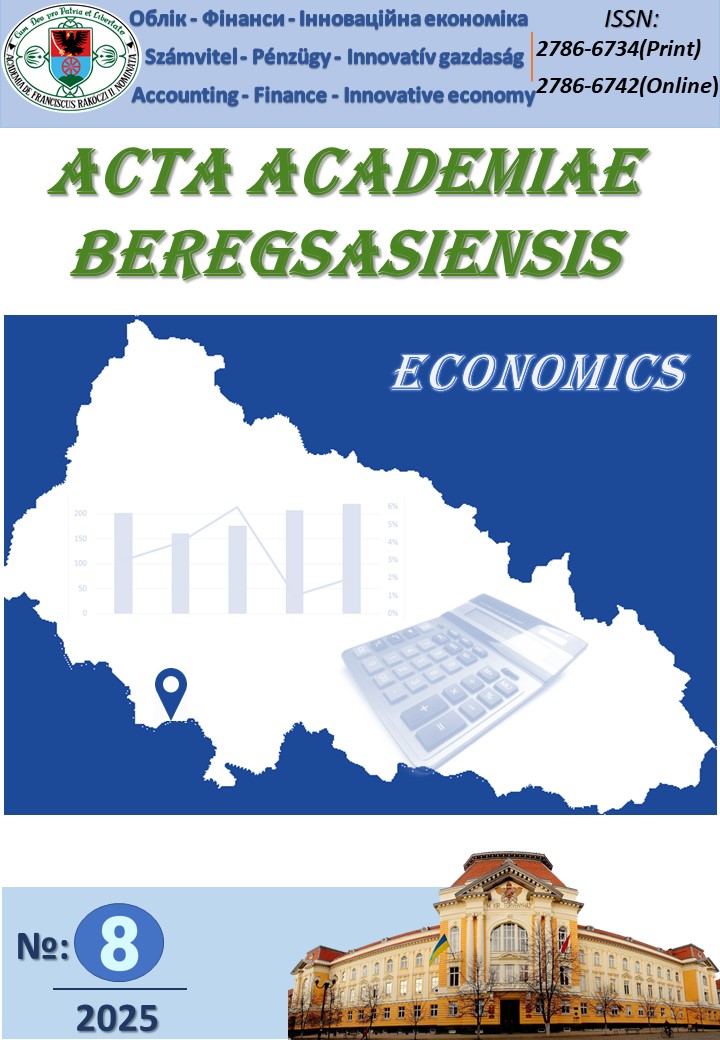The Resource Potential of Agricultural Enterprises as the Basis for Innovation-Driven Diversification
DOI:
https://doi.org/10.58423/2786-6742/2025-8-297-311Keywords:
resource potential, agricultural enterprises, innovation, diversification, sustainable development, niche cropsAbstract
In the context of the dynamic development of the agricultural sector and the growing challenges of the global economy, the issue of efficient utilization of the resource potential of agricultural enterprises is becoming increasingly significant. Innovative diversification of activities serves as a key tool for enhancing the competitiveness, stability, and adaptability of agribusiness to changes in the external environment. The relevance of this topic is driven by the need to develop and implement strategies for innovative diversification that ensure the sustainable development of agricultural enterprises and reduce dependence on fluctuations in traditional segments of the agricultural market. The aim of this study is to provide a theoretical justification and develop practical recommendations for the effective utilization of the resource potential of agricultural enterprises as a foundation for their innovative diversification. This article examines the resource potential of agricultural enterprises as a key prerequisite for the innovative diversification of activities. The main components of resource provision, including land, material and technical, financial, and human resources, are analyzed, along with their impact on diversification opportunities in the agricultural sector during the post-war period. The components of the potential for the diversification of agricultural enterprises on an innovative basis are explored in detail. The advantages and disadvantages of applying this approach to enterprise development are highlighted. It is established that the restoration of Ukraine’s agricultural sector should begin with the diversification of production, particularly through the active implementation of niche agricultural crops. This will contribute to strengthening food security, ensuring the efficient use of land resources, and adapting to climate change. Additionally, it may become a key direction for development and financial stability for small businesses. For the effective development of niche crops, it is necessary to create favorable conditions, including strengthening informational support for farmers, introducing transparent market mechanisms, developing state incentive programs, and promoting the implementation of modern technologies in production processes.
References
Dobryanska, N. A., & Nikiforchuk, A. A. (2013). Evolution of production diversification, motives, and goals. Effective Economy, 9. URL: http://www.economy.nayka.com.ua/?op=1&z=2306 [in Ukrainian].
Martiyanova, M., Kuprina, N., & Basyurkina, N. (2023). Enterprise diversification strategies: Classification, implementation principles, and development stages. Bulletin of Khmelnytskyi National University, 4. 440-445. URL: http://journals.khnu.km.ua/vestnik/wp-content/uploads/2024/03/320-66.pdf [in Ukrainian]. DOI: https://doi.org/10.31891/2307-5740-2023-320-4-66
Sitkovska, A. O., Polehenka, M. A., & Borodei, D. E. (2024). Production diversification as a direction of strategic development of an agricultural enterprise. Investments: Practice and Experience, 2. 111-114. URL: https://www.nayka.com.ua/index.php/investplan/article/view/2809/2845 [in Ukrainian].
Ochieng J., Kirimi L., Ochieng D.O., Njagi T., Mathenge M., Gitau R. & Ayieko M. (2020). Managing climate risk through crop diversification in rural Kenya. Climatic Change, 162, pp. 1107-1125 URL: https://link.springer.com/article/10.1007/s10584-020-02727-0 DOI: https://doi.org/10.1007/s10584-020-02727-0
Adnan K.M. , Ying L., Ayoub Z., Sarker S.A. , Menhas R., Chen F. & Yu M. (2020). Risk management strategies to cope catastrophic risks in agriculture: the case of contract farming, diversification and precautionary savings. Agriculture. 10 (8). 351 URL: https://www.mdpi.com/2077-0472/10/8/351 DOI: https://doi.org/10.3390/agriculture10080351
Grilli G., Pagliacci F. & Gatto P. (2025). Agricultural Diversification at the Margin. Strategies and Determinants in Italian Mountain and Remote Areas. Agribusiness. https://doi.org/10.1002/agr.22042 DOI: https://doi.org/10.1002/agr.22042
Grilli G., Pagliacci F. & Gatto P. (2024). Determinants of agricultural diversification: What really matters? Journal of Rural Studies. 110. URL: https://www.sciencedirect.com/science/article/pii/S0743016724001694 DOI: https://doi.org/10.1016/j.jrurstud.2024.103365
Petrenko, O., & Makedonskyi, A. (2018). Increasing the efficiency of resource potential use in agriculture. Agrarian Economics, 1(1–2), 44–55 [in Ukrainian].
Kukhar, O. V., Kryukova, I. O., & Rudenko, S. V. (2024). Implementation of the potential of agricultural business diversification to reduce sustainable development risks. Ukrainian Journal of Applied Economics and Technology, 9(1). 24-28 URL: http://ujae.org.ua/wp-content/uploads/2024/02/ujae_2024_r01_a3.pdf [in Ukrainian]. DOI: https://doi.org/10.36887/2415-8453-2024-1-3
State Statistics Service of Ukraine. (2023). Statistical Yearbook of Ukraine for 2023. URL: https://ukrstat.gov.ua/druk/publicat/kat_u/2023/zb/11/year_23_u.pdf [in Ukrainian].
Shevchenko, A. A., Petrenko, O. P., & Dobryanska, N. A. (2017). Innovative development of agricultural enterprises. Agrarian Bulletin of the Black Sea Region, 200–213 [in Ukrainian].
Lahoha, R. V. (2024). Development of an agricultural business diversification model based on the circular economy. Scientific Innovations and Advanced Technologies, 6(34). 872-878. URL: http://perspectives.pp.ua/index.php/nauka/article/view/12234/12295 [in Ukrainian].
Stepasyuk, L. M., & Stepasyuk, M. O. (2024). Diversification of agribusiness through the expansion of niche oilseed crop cultivation. Economy and Society, 67. URL: https://economyandsociety.in.ua/index.php/journal/article/view/4827/4767 [in Ukrainian].
Dobryanska, N. A., & Nikiforchuk, A. A. (2013). Influence of the economic and institutional environment on the activities of diversified corporate associations. Bulletin of KhNAU. Economic Sciences, 6, 117–122 [in Ukrainian].
Vovk, M. V., & Stibel, R. I. (2024). Diversification of agricultural enterprises as the basis for industry development. Scientific Bulletin of LNUVMB named after S. Z. Gzhytskyi, 26(104), 19–24 [in Ukrainian]. DOI: https://doi.org/10.32718/nvlvet-e10404
Kozyk, V. V., & Stepankiv, N. Z. (2024). Diversification as a method of ensuring stable enterprise development. Business Inform, 2, 153–159. URL: https://doi.org/10.32983/2222-4459-2024-2-153-159 [in Ukrainian]. DOI: https://doi.org/10.32983/2222-4459-2024-2-153-159
Petrenko, O. P., & Shevchenko, A. A. (2024). Adaptation of agricultural production to wartime realities: Ensuring Ukraine’s economic security. Galician Economic Bulletin, 88(3), 20–29 [in Ukrainian]. DOI: https://doi.org/10.33108/galicianvisnyk_tntu2024.03.020
Boiko, L. O. (2024). Competitiveness of niche crops in agribusiness under uncertainty conditions. Agrosvit, 20. URL: https://nayka.com.ua/index.php/agrosvit/issue/view/176/133 [in Ukrainian].
Mirzoiev, T. D. (2024). Current state and prospects of niche industrial crops production. Actual Problems of Economics, 1(271). 6-14. URL: https://eco-science.net/wp-content/uploads/2024/01/1.24.topic-Timur-Mirzoiev-6-14.pdf [in Ukrainian]. DOI: https://doi.org/10.32752/1993-6788-2024-1-271-6-14
Downloads
Published
Issue
Section
License
Copyright (c) 2025 Alisa Shevchenko, Olga Petrenko, Maxim Nikiforchuk

This work is licensed under a Creative Commons Attribution-NonCommercial 4.0 International License.
Authors retain copyright and grant the journal right of first publication with the work simultaneously licensed under a Creative Commons CC BY-NC License.


